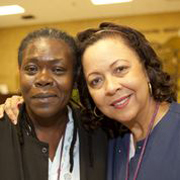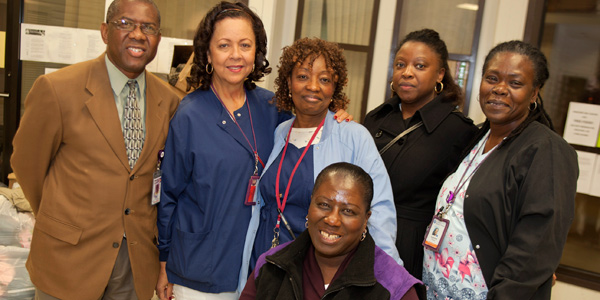“They Were Like Battlefield Nurses”: 1199 RNs Comfort Victims As Sandy Tore Through Area
November 15, 2012
As Hurricane Sandy raged through the Rockaways in Queens, NY, St. John’s Episcopal Hospital became the community’s de facto emergency shelter and center of calm for many residents who either did not or could not leave the peninsula.
RN Shirley Benjamin, at St. John’s for 17 years, works in the hospital’s Ambulatory Care Center. “I came in the day of the storm, Monday,” she said. “They sent for me. Based on my ER experience I was drafted into the emergency room. I was able to jump right into the situation. At home I had a blackout and no heat. Based on what I saw, it’s nothing to complain about.”
Benjamin says that as Sandy gathered strength, the hospital not only served the sick and injured, but frightened Rockaways residents who simply had nowhere else to go.
“As the evening went on more people came in soaking wet. Their perceived fear was very high and they had to be dealt with in triage,” she said. “It was of paramount importance that we stayed calm. You saw things get progressively worse through the night.”
Benjamin reserved special praise for her co-workers, RNs Laphine Tracey and Adelite Roberts, Tracey and Roberts stayed in St. John’s ER for 36 hours while Sandy swept through New York City.
“[Tracey and Roberts] kept the ER going and were able to direct us and get patients where they were supposed to be. They carried our ER through those trying hours,” said Benjamin. “Ms. Tracey kept the patients flowing in an orderly way and Adelite injected humor into things to help us relieve some of the tension.”
“It’s just second nature,” said Roberts, brushing off any praise. “You just do it. You don’t worry about anything. You don’t eat. You don’t sleep. I just got lights back on in my house yesterday.”Patients were also Tracey’s main concern. “I live in Jersey City,” she said. “I came in not knowing what was going on at home. It was so intense here. You just had to focus on that. One guy came in with blood on his hands from trying to keep his windows from breaking. There was a mother that came in twice in every shift just to plug in her nebulizer because her daughter was asthmatic. We were a safe haven. If people were wet, they got dry clothes. If they were clod we gave them blankets.”
“We had a lot of people who were really fantastic, but they really kept it together,” said St. John’s ER RN Iona Folkes. “That ER was inundated with people seeking shelter. They were like battlefield nurses.”



